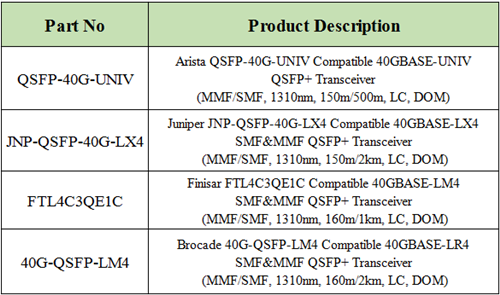
fiber optic communication networks and solutions
March 28 2016
Currently, data centers and networking environments are undergoing a tremendous transformation, requiring higher speeds, greater scalability, and higher levels of performance and reliability to better meet the demands of business. As speed and performance needs increase, optical transceivers have become an integral part of overall system design. However, optical transceiver design margins and parameters vary widely, and can be the difference between an optimized, highly reliable fabric and incompatibility issues that drive up support costs. Today’s article will illustrate a special optical transceiver—SMF&MMF 40G QSFP+ and its unique advantages to upgrade to 40G.
As we all know, a fiber optic transceiver may either operate on multimode fiber (MMF) or single-mode fiber (SMF). However, a SMF&MMF 40G QSFP+ transceiver can be used with both MMF and SMF without the need for any software/hardware changes to the transceiver module or any additional hardware in the network. Usually, this transceiver is based on IEEE defined 40GBASE-LR4 specifications and operates in the 1310nm band. It uses a duplex LC connector and supports distances up to 150 m over OM3 or OM4 multimode fiber and up to 500 m over single-mode fiber (different vendor may have different specifications). This is usually accomplished by combining four 10G optical channels at different wavelengths (1270, 1290, 1310, and 1330 nm) inside the transceiver module to transmit and receive an aggregate 40G signal over a single pair of multimode or single-mode fibers.

At present, there are two main SMF&MMF 40G QSFP+ transceiver in the market. One is the Arista QSFP-40G-UNIV universal QSFP+ transceiver, and the other is the Juniper JNP-QSFP-40G-LX4 40GBASE-LX4 QSFP+ transceiver. These two types QSFP+ for both MMF and SMF are widely installed and used for upgrading from 10G to 40G networks without modification or expansion. The Brocade 40 Gbps LM4 QSFP+ optical transceiver, part of the Brocade family of optical transceivers, is optimized to fully leverage Brocade 40 Gigabit Ethernet (GbE) switches and routers. Together, these optical transceivers provide state-of-the-art performance, helping IT organizations achieve new levels of infrastructure consolidation while expanding the capabilities of their applications and services. The following picture shows Fiberstore SMF&MMF 40G QSFP+ transceiver solutions.

With the increase in data center bandwidth requirements, migration to 40G for switch to switch connections is in higher demand. SMF&MMF 40G QSFP+ transceiver is designed to allow for seamless migrations from existing 10G to 40GbE networking without requiring a redesign or expansion of the fiber network. Besides, this transceiver also provides a cost-effective solution to migrate from multimode to single-mode fiber, allows a single-mode fiber infrastructure for distances up to 500m. The following part presents the unique merits of SMF&MMF 40G QSFP+ transceiver.
Existing 40G transceivers for short reach, QSFP+ SR4 and the extended reach QSFP+ CSR4, utilize four independent 10G transmitters and receivers for an aggregate 40G link, which use an MPO-12 connector and require 8-fiber parallel multimode fiber (OM3 or OM4). However, a SMF&MMF QSFP+ uses duplex LC connector, which is consistent with the existing 10G connections, which are also commonly MMF cables with duplex LC connectors. Therefore, a SMF&MMF QSFP+ allows the same cables to be used for direct 10G connections to direct 40G connections, resulting in zero-cost cabling migration.
As existing MMF 40G solutions need the use of 8 fibers for a 40G link, customers have to add additional fiber to increase the number of 40G links. By deploying the SMF&MMF 40G QSFP+ transceiver, customers increase the number of 40G links by 4 times without making any changes to their fiber infrastructure, which greatly expand network scale and performance.
As data rates increase from 40G to 100G and beyond to 400G, there is a strong desire for data centers to move to single-mode fiber for cost effectiveness. Due to the limitations of multimode transceivers to support existing distances with ever increasing data rates, migrating to 100G and 400G in the future will be simpler with single-mode fiber. However, the single-mode transceivers typically cost up to 4 times more compared to multimode transceivers. As SMF&MMF QSFP+ interoperates with 10km QSFP-LR4 optics, it s a cost effective solution for SM fiber infrastructure for distances up to 500 m.
The SMF&MMF 40G QSFP+ transceiver offers the unique advantage of operating on both multimode and single-mode fiber without any requirement for additional hardware or software. Customers can consolidate their optics and use SMF&MMF QSFP +in their network irrespective of the fiber type, which makes full use of the existing cabling systems, reduces the cost of deployment and of support, and simplify purchasing and deployments.
The SMF&MMF 40G QSFP+ transceiver offers a transition path for customer planning migrations to single-mode fiber in data centers with a single transceiver that bridges the gap between multimode and single-mode optics, enabling data centers running at 10G today to seamlessly upgrade to 40G without having to re-design or modify the cable infrastructure. Fiberstore provides a cost-effective solution to smoothly migrate to 40G data center deployments. Our SMF&MMF 40G QSFP+ transceivers are well-tested and fully compatible with major brand. If you have any requirement of our products, please send your request to us.